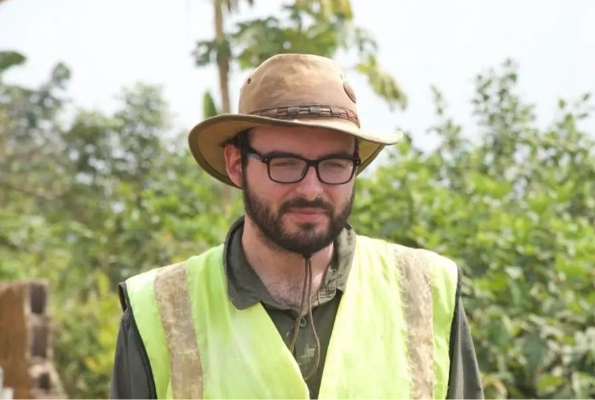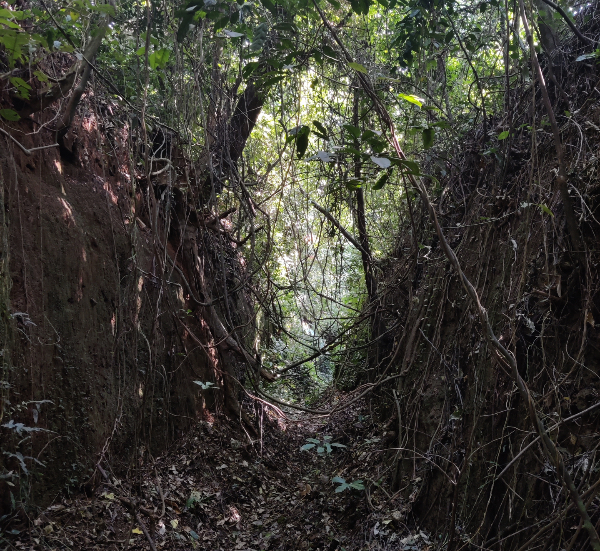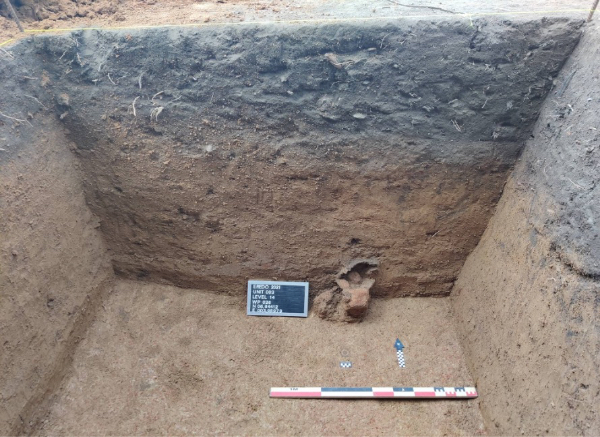博士候选人Tomos Evans获得温纳-格林博士论文实地考察资助

六年级博士候选人Tomos Llywelyn Evans最近获得了著名的Wenner-Gren基金会论文实地考察补助金,这笔资金将用于资助他在2023年在尼日利亚西南部的一个巨大的土方工程Sungbo 's Eredo进行考古研究。埃雷多周长100英里,被认为是非洲最大的单一结构,也是life - sungbo考古项目的研究重点。该项目是尼日利亚和国际机构之间的研究伙伴关系,自2015年以来在拉各斯州的埃雷多进行了研究,得到了奥古斯丁大学社区、埃雷多村和伊拉拉-埃佩皇家宫殿的慷慨支持。Tomos在这一更大的倡议的保护下经营着自己的合作项目,自2018年以来,他在尼日利亚南部领导了几个实地季节。最近,他与尼日利亚的博士生同事Emmanuel Adeara和Stanley Osinachi Nwosu合作,于2021-22年完成了由伦敦皇家人类学研究所和探险家俱乐部华盛顿小组资助和支持的实地调查。
在这篇重点报道的文章中,博士生Graham Callaway向Tomos询问了他在Sungbo的Eredo正在进行的工作,讨论了该地区土方工程景观的性质,以及随着时间的推移,连续的当地社区参与和概念化它们的方式的变化。在进入威廉玛丽学院之前,你有什么背景?你是如何开始关注非洲考古的?我在剑桥大学开始了考古学和人类学的本科学习。长期以来,我一直被这些学科所吸引,因为它们将人文和科学方法创造性地融合在一起,而且它们愿意去那些用传统的历史方法往往无法到达的地方。剑桥大学提供了关于非洲考古学的精彩课程(包括更新世和全新世),这些课程向我展示了整个非洲大陆过去社会的惊人范围,这些社会在全球北方的流行和学术话语中经常被边缘化。我对非洲考古的关注一直是为了揭示这些社会的进一步证据——他们的技术专长、艺术创造力,以及不断发展的感知世界和与世界互动的方式。在南部和东部非洲从事考古和文化遗产工作之后,我在伦敦大学学院(University College London)攻读了非洲遗产研究硕士学位。正是在这里学习期间,我被尼日利亚壮观的考古所吸引。不久之后,我加入了life - songbo考古项目,该项目的部分总部设在威廉与玛丽学院,在与格萨拉德·乔因教授交谈后。我现在由他和尼尔·诺曼教授共同指导,他们是非洲土方研究领域的两位顶尖专家!你能给我们介绍一下你对松波埃雷多土方工程的研究吗?它们是什么?你希望回答哪些问题?Sungbo的Eredo是一个巨大的线性土方工程,由尼日利亚西南部的大型银行和沟渠组成,与Ìjèbú王国有关,该王国至少从公元15世纪就存在于此,当时被葡萄牙旅行者记录下来。当地的口述传统表明,埃雷多是由一位名叫松布的强大统治者建造的,作为对她自己的一种纪念。我的研究探索了这个前所未有的巨大土方工程是何时、如何以及为什么被这个地区的社区建造和参与,作为一个更广泛的、相关的精神景观的一部分。我的项目在很大程度上融合了考古和档案工作,以及对神社和当代景观中其他有意义的当地记忆遗址的调查,以获得一些长期的视角,了解当地对松博埃雷多的参与和概念化。

You have described Sungbo's Eredo as “a monumental composition within its broader landscape.” Can you elaborate on what this means and the importance of these ideas to your work?
The concept of “composition”, as I use it, is documented in a range of historical and ethnographic writing on West and Central Africa. But it’s perhaps Jane Guyer and Samuel Eno Belinga in their famous article in 1995 (Wealth in People as Wealth in Knowledge: Accumulation and Composition in Equatorial Africa) who offer the most detailed description of it. The crux of this idea is that many Central and West African societies have typically valued the bringing together of different agencies and bodies of qualitative knowledge – of people, material objects, spiritual entities etc. – synergizing them into new combinations that act upon the world in novel ways. Guyer and Belinga describe the ways in which such logics manifest in social organization in Central Africa. Here, effective rulership is often that which successfully accumulates and brings together the qualitatively distinct skills, knowledge, and practices of different individuals and collectives into synergistic composites, where the different “parts” of the whole are interdependent and constantly interacting. Similarly, study of West African architectural practices has shown the creation of earthen architecture to be a complex process involving the composition of knowledge and abilities of different architects, craftspeople, spiritual entities, and associated ritual medicines to ensure successful construction. I’m looking to investigate the extent to which such widespread concepts of wealth-in-people, wealth-in-knowledge, and composition are manifest in, and actively shaping, the monumental landscape. This can shed light on the ways that monumental and shrine features may have accumulated in synergistic ways that were seen to empower Sungbo’s Eredo to achieve and enact its essential purpose(s) within Ìjèbú society. I’m foregrounding the diachronic aspects of these processes: how they transformed this landscape throughout the course of West African history.
You note that previous work with African earthworks has usually interpreted them as relating to defense, prestige, political consolidation, and religion. How does your work bring a different perspective to this topic?
The main dimension of my analysis that I feel has been previously underutilized is greater consideration of the ways in which successive Ìjèbú communities conceptualized the earthwork according to their own worldviews. This is aimed at moving beyond ethnocentric terminologies and assumptions. For example, when scholarship considers “defensive” walls, it typically assumes physical, military defense, such as against attacking armies or raiding groups. While this is certainly likely, it’s important to also consider what specific ways local people thought about such concepts as “defense” or “regulation” in this region over time, and where these overlap with and/or diverge from more normative approaches in the social sciences. For instance, ethnographic evidence across Yorùbá-speaking regions (and beyond) shows that people protected and regulated the thresholds of their houses and compounds from more than just “physical” invasion. Such thresholds were also considered bulwarks against dark powers from beyond the dwelling, such as forms of disease and misfortune, with shrines to liminal deities such as Èsù playing a role in that protection. Such threshold logics were applied to a multitude of scales (not only those of the household) including those of town walls and enclosures. We need to similarly problematize notions such as “prestige” to consider how such concepts would have been imagined here, and connected to potentially very distinct notions of society and being.
What relationships do nearby settlements have to Sungbo's Eredo, and how have these relationships changed over time?
The earthwork shows evidence of continued modification by local communities. You can see areas where mounds and causeways were added to it, and new entryways opened through it, said to have been regulated by toll gates and associated shrines. Monumental discard mounds are also observed to cluster around certain parts of the earthwork. Our excavations of a couple of these revealed interesting patterns in which successive generations of local people piled up discard in the same spaces, sometimes on top of earlier collapsed architectural features. Gradually, these features became large monumental structures of the earthwork landscape. Our excavation revealed them to be full of local ceramics, European manufactured wares, cowrie shells, coins, gin bottles, beads, animal bones, giant snail shells, and various other objects. These would have demonstrated the accumulated wealth and evolving identities of the compound communities that discarded them, reflecting aspects of their occupation, consumption, and connections with the land. Locals and incoming travelers crossing the Eredo would have observed these monumental mounds as they moved through this landscape.

今天居住在土方附近的当地人是如何理解它的?这些观点会影响你的工作吗?今天,这个地区不同的个人和团体以多种方式理解埃雷多。该地区的新来者往往不知道它的存在,这导致在一些地方,为了给农业腾出空间或获取建筑材料和空间而破坏了该地区。这是一个合作项目——William & 玛丽在其中发挥主导作用——正在寻求通过数字保存(使用激光雷达)以及旨在与各种利益相关者进行头脑风暴的当地研讨会来解决的问题。然而,对于其他一些社区来说,土方工程具有重要的文化和/或精神意义。对他们来说,埃雷多景观代表了社区生活中关键地点的重要组合,包括几个òrìsà(“神”)的神圣神殿。作为公认的国家纪念碑,它也是当地管理人员的一个有用的收入来源,因为它吸引了来自附近拉各斯和其他地方的国内游客。此外,口头传统有时将松波的性格与古兰经/圣经中的示巴女王联系起来,认为土方工程更多的是纪念而不是政治或精神边界,我的研究探索了松波和埃雷多以这种方式被看待的方式。这些想法对我的工作产生了重要的影响:一方面,它们为埃雷多的一些潜在的更深层的时间用途提供了线索,另一方面,它们可能揭示了随着时间的推移,土方工程景观的材料实践和解释的变化,以及它在几个世纪以来直到今天如何继续作用于(和被作用于)当地社区。
















